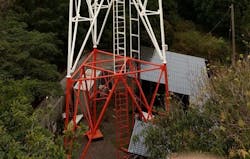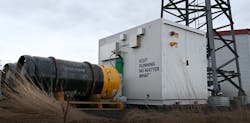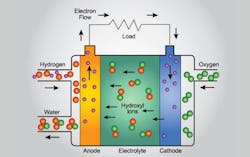It Is Possible
Telecom networks are energy intensive. While energy efficiency is constantly improving, the total amount of data transmitted is increasing as digitalization advances and conquers more and more sectors of our private lives and business applications. Cloudification and the introduction of 5G are related to this development. This is why the total energy consumption is still rising despite significant energy efficiency efforts from Broadband Service Providers.
Telecommunication companies are also rushing to cut their carbon emissions. Remote towers are increasingly vulnerable today to power outages because they are under increasingly higher risks of storms, floods and other extreme weather events that are increasingly severe and frequent because of climate change. Climate resilience becomes an increasingly important topic for telecom companies.
Even more obvious is the need for on-site power generation at remote telecom tower sites that are not connected to the national grids. While historically, they run on diesel gensets only, small-scale renewable energy power plants have since been added—mainly solar arrays. Solar is an intermittent energy source that needs to be balanced. This article will introduce and compare different solutions such as a dynamic use of diesel gensets, batteries and fuel cells.
Energy related questions are an important topic as energy costs are a substantial cost block for telecom operators. Already, before the current global energy crisis, they accounted for approximately 5% of operating expenditures.1
“Hydrogen can be both an energy storage solution and a fuel. Hydrogen is produced on-site from solar or wind energy and converted in electrolysis plants to hydrogen. It can then be stored in tanks and reconverted into electricity when needed. That’s how it can assume the role of an energy storage system.”
Off-Grid Tower Powering Options
Reliability is key in telecommunications. Unplanned power outages can mean a loss of service to critical customers which can translate into a loss of huge amounts of money or even the loss of lives. This is why the telecommunications infrastructure must be powered extremely reliably. Below are a few options providers can employ to deliver the ultra-reliability their customers’ demand:
Option A: Diesel Gensets
In remote locations, telecom towers are typically powered by diesel gensets. Diesel generators are very flexible, meaning they can easily adapt to load changes of the telecom tower. However, diesel gensets also come with several severe problems. They require regular maintenance which can be particularly costly at remote sites, and they are much less efficient than large-scale grid-connected power plants.
The main issue with diesel is that it is not environmentally friendly. This is valid in different dimensions. Diesel is carbon-intensive and contributes significantly to climate change. Additionally, diesel also comes with on-site pollution, from noise to hazardous emissions, that can cause cancer.
Option B: Solar-Diesel Hybrid
Solar and small-scale wind turbines might be used at remote telecom towers as an option to diesel. (See Figure 1.) As renewable energy sources, both solar and wind energy are carbon-neutral and do not require any fuel. However, they are also intermittent energy sources, and their output depends on solar irradiation or wind speeds.
These options cannot match the energy loads that remote telecom towers require. This is why diesel gensets are not really replaced but rather operated at lower loads whenever the sun is shining, or the wind is blowing.
Diesel gensets can quickly respond to power losses due to shading of the solar arrays being shaded or if the winds stop. That said, operating diesel gensets in such a dynamic way can increase their maintenance needs as they are typically optimized for operating at rather high loads.
Option C: Solar-Diesel Hybrid with Batteries
Solar-diesel hybrid solutions reduce diesel consumption typically in the range of 15-25%. They can also contribute to decarbonization. While it’s important to deploy as many solar-diesel hybrid solutions as possible at remote telecom sites, it’s obvious that this approach is far from being carbon-neutral.
Diesel gensets can also be supported by batteries that allow diesel gensets to be switched off during sunny and/or windy days. In those situations, the diesel gensets are switched off and the batteries balance the gap between the intermittent renewable energy source and the requirements from the telecom tower.
Batteries can reduce the wear on diesel gensets by running them more steadily. They can also be a bridge-for-backup, meaning they can provide energy until the diesel genset is started, which might take up to a couple of minutes.
The share of renewables is seldomly beyond 50%. Even for such a modest looking renewable energy share, the capital requirements for batteries can be rather high.
Option D: Hydrogen and Ammonia
Seasonal fluctuations on the supply side (for instance weather-based) or the demand side, require long-duration energy storage systems or fuel-based solutions.
Hydrogen can be both an energy storage solution and a fuel. Hydrogen is produced on-site from solar or wind energy and converted in electrolysis plants to hydrogen. It can then be stored in tanks and reconverted into electricity when needed. That’s how it can assume the role of an energy storage system. (See Figure 2.)
In some applications, it might be too complex to run a small-scale electrolyzer on-site to produce green hydrogen locally. In those cases, hydrogen is transported in liquid form in specialized trucks to remote sites.
Option E: Fuel Cells
Instead of burning fuel to create electricity, fuel cells rely on an electrochemical reaction that does not create any greenhouse gases and only clean vapor as local emissions. Three different types of fuel cells are:
- PEM Fuel Cells (PEMFCs)
PEMFCs consist of two electrodes (an anode and a cathode) with a thin platinum layer of catalyst, bonded to either side of a proton exchange membrane. Their acidic nature requires the use of platinum cathodes.
Membrane fuel cells typically require water for membrane hydration. If water and the heat of the fuel cells are not carefully managed, the performance of the membranes will start to dry out and conductivity will decline, or condensation could flood the electrodes. Therefore, they must be operated in conditions above freezing or be placed in a heated and insulated enclosure.
This option also requires expensive electrocatalysts, typically made of platinum, to support the reactions that occur at low temperatures—an important factor that drive costs of PEMFCs. - Alkaline Fuel Cells (AFCs)
The term alkaline fuel cells come from the use of an alkaline electrolyte such as potassium hydroxide (KOH) in water. AFCs are particularly efficient, reaching up to 60% efficiency and up to 87% for heat and power combined.
The circulating liquid electrolyte offers benefits compared to low temperature membrane-based fuel cells like PEM. (See Figure 3.)
The electrolyte (KOH) used in alkaline fuel cells has a freezing temperature of below -40 degrees Celsius. This allows their use in sub-freezing conditions. Liquid electrolyte also avoids many of the challenges with membrane humidification including limited operation in certain high and low humidity conditions. That means that AFCs can operate in a greater range of temperature and humidity conditions. This type of fuel cell also features a short start-up time.
The liquid catalyst makes AFCs relatively heavy. While they are not ideal for mobile applications, they can be used at telecom remote sites. Their significantly higher efficiency also translates into fuel savings and lower transportation needs and costs.
The main issue that remains with standard AFCs is the alkaline electrolyte which is quite sensitive to any CO2 in the fuel or oxidant stream. The hydrogen-oxygen (anaerobic) AFC achieves an efficiency significantly higher than that of other types of fuel cells. It also uses ambient air as an oxidant, with a concentration of CO2 of 300-450ppm. In the presence of CO2, KOH electrolyte degrades and can form carbonates, which ultimately affect the durability and longevity of the AFCs operation. This problem is typically resolved by means of air scrubbers (regenerative and non-regenerative) that reduce the CO2 concentration in the incoming air. - Advanced Alkaline Fuel Cells (AFCs)
One company, GenCell, has made several patented improvements in AFC technology that optimize their fuel cells for stationary applications. Capital costs have substantially been reduced by using non-precious metal catalysts instead of precious metal catalysts—typically made of platinum or platinum alloys.
If the fuel cells are powered by locally generated green hydrogen, the requirements for the electrolysis process and hydrogen storage are lower. This could turn into another important cost advantage.
However, transporting and storing hydrogen at remote sites remains a challenge. This is where ammonia comes into play. When hydrogen is extracted from ammonia and fed into the fuel cell, it is one of the most effective and energy-dense carbon-free hydrogen carriers, with only water, nitrogen, and heat as by-products. Green ammonia is carbon-free as it relies on green hydrogen.
Recommendation
Sustainability, costs, and resilience are the key factors for telecom operators when they address energy these days. There is a strong need to decarbonize AND maintain almost 100% reliability for the network infrastructure.
This article explored several options for powering remote telecom sites. Each remote site is location-centric and unfortunately, there is not a “one-size-fits-all” solution. The best course of action is to trial one or two in the field and rigorously test them. Only then, will it be clear which is the best fit for the short and long term.
REFERENCES AND NOTES
1. https://www.mckinsey.com/industries/technology-media-and-telecommunications/our-insights/the-case-for-committing-to-greener-telecom-networks
About the Author
Dr. Thomas Hillig
Consultant and Managing Director, THEnergy
Dr. Thomas Hillig is a Consultant and Managing Director at THEnergy. He has more than 18 years of experience in the energy sector with a focus on cleantech innovations. For more information, please email [email protected] or visit: www.th-energy.net. Follow him on Twitter @THEnergyNet and LinkedIn: https://www.linkedin.com/company/thenergy/.



